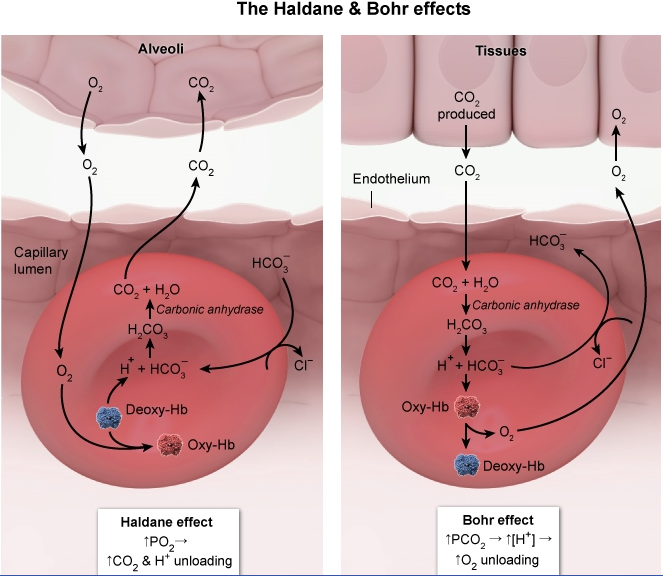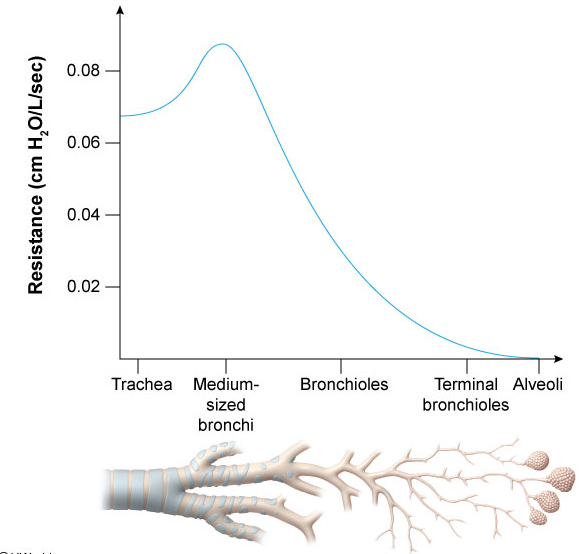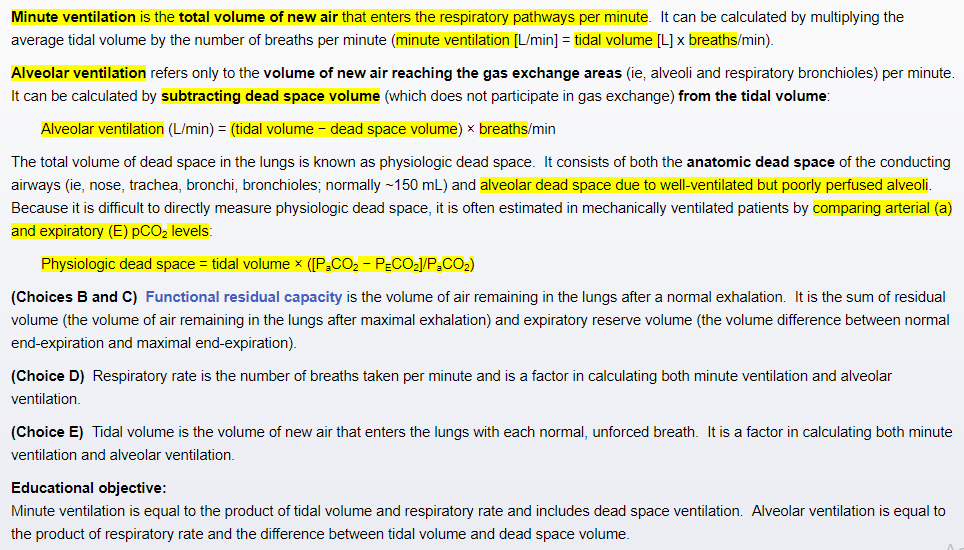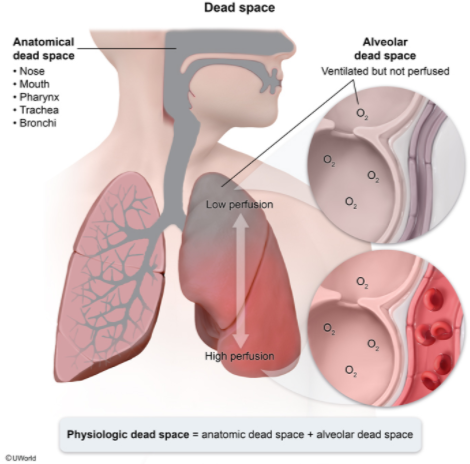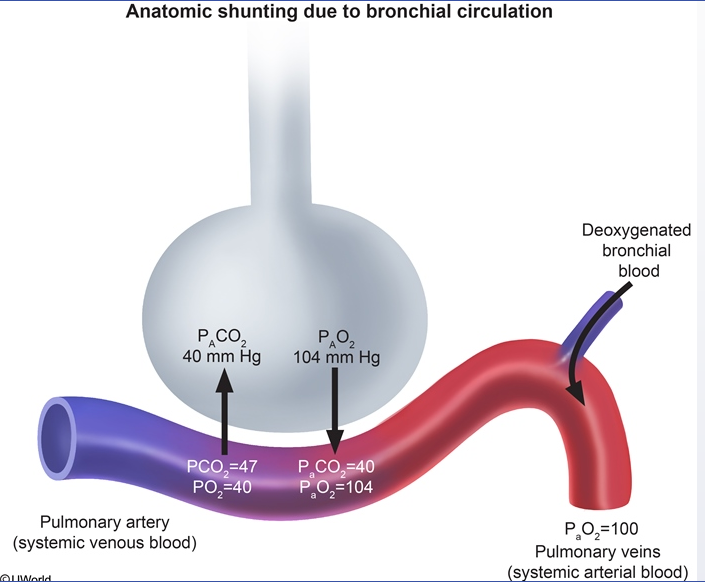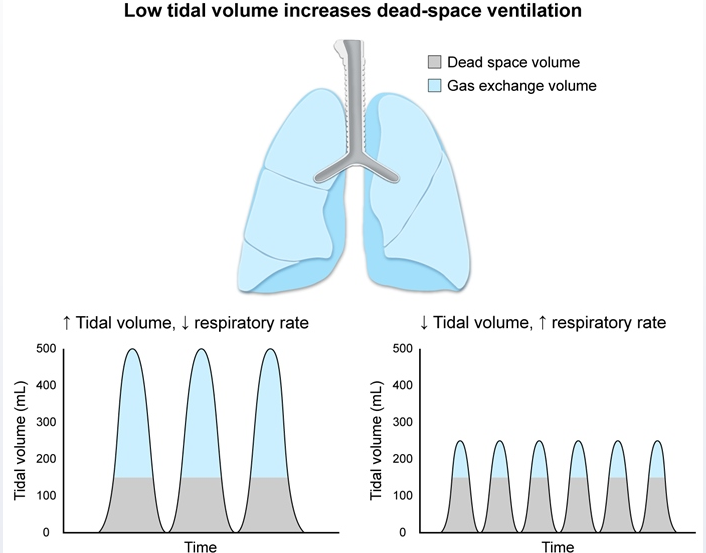Respiratory - Anatomy and Physiology
*Alveolar Cells
- type 1 pneumocytes = squamous gas exchange cells
- type 2 pneumocytes = cuboidal surfactant cells
Type
Blood BB and Tight Junctions
Notes:
- note that type 2 pneumocytes have the unique ability to proliferate themselves and also be progenitor cells for type 1 pneumocytes
- type 1 cells make up 95% of the alveoli, where type 2 are only 5% but they are completely necessary for their progenitation of type 1 cells and for the surfactant they make to stop the alveoli from collapsing
Clinical Case
Lung Anatomy
Change of Cells from Trachea --> Bronchi --> bronchioles --> Alveoli
Change of cells as moving towards alveoli
- cilia important to move things up
- important for cilia below the mucus making cells
--> stop mucus accumulation near alveoli
Notes:
- note that the cilia are the last things to leave as moving distally before the alveoli
--> make sure no mucus or anything ends up in the alveoli - in the alveoli you start to get the type 1 pneumocytes and type 2 pneumocytes
- type 1 pneumocytes = 90% = squamous cells = gas exchange
- type 2 pneumocytes = surfactant makers = proginators for type 1 pneumos
Clinical Case
*Hemoglobin
Haldane Effect (in lungs)
- unloading of CO2 and loading of O2
- Hb need to deliver H+ protons also to convert bicarb (= primary transporter of CO2)
--> into CO2 and H2O
Clinical Cases
Clinical Case
Notes:
- note that
Clinical Case
Bronchioles and Resistance
- generally decrease exponentially
--> only exception is initially there is a decrease in SA and slight increase in resistance
*Minute Ventilation / Alveolar ventilation
- how much air enters the TOTAL respiratory system
--> includes physiological deadspace
Physiological dead space
- anatomical + alveolar dead space
*Clinical Anatomy of Lungs
- 6,8,10, 12 rule for lung markings
*Clinical Symptoms in Respiratory Diseases
- dyspnea, SOB, pleuritic chest pain
Notes:
- ONLY the parietal pleura has pain sensation
--> parietal = PAIN - viscera pleura has NO pain sensation
- note there are 4 separate parietal pleura in the lungs for all the different surface
- the phrenic nerve gives pain sensation to the diaphragm and mediastinal parts
- the apices and costal parietal are from the intercostal nerves
*PFTs = Pulmonary Function Tests
COPD PFTs
- increase
PFTs and *Aging Lungs
- Total lung capacity stays the same throughout your life
- calcification of ribs and osteoporosis/increased kyphosis
--> decreased compliance of chest wall - loss of elasticity of lungs
--> increased compliance of lungs - these 2 compliances cancelling each other out
--> leads to the unchanged TLC - elements of both restrictive and obstructive disease
- obstructive --> alveoli increase in size = air trapping
- restrictive = FEV1 decreases from restrictive compliance of the chest cavity
Clinical Cases
Clinical Case
Notes:
- note that
Clinical Case
*Home
*ABGs
- Arterial Blood Gases
*High Altitude ABGs
- hypoxemia due to low pressures of O2
- carotid mecahnoreceptors sense low O2
--> central resp hyperventilate
--> expel CO2, still no O2 increase - arespiratory alkylosis
- takes 24 hours for renal compensation of bicarb
Clinical Cases
Clinical Case
Notes:
- note that
Clinical Case
*Gas Exchange in the Lungs and Alveoli
- normal O2 arteriole = 100
- normal CO2 arteriole = 40
--> note ONLY 45 in veins, not much higher - O2 and CO2 are almost the same on their way back through the veins
--> CO2 is only slightly higher , PCO2 = 45, PO2 = 40
DIffusion vs Perfusion effects on O2 and CO2 in blood
- under normal circumstances, alveolar walls have quick enough diffusion so that perfusion is the main limiting factor in gas exchange
- during 1/3 trip through the pulmonary veins, the blood already equilibriates
- ONLY in 2 cases = exercise and Pulmonary fibrosis/emphysema = when diffusion is the limiting factor
--> alveolar walls too thick in IPF and COPD
--> in exercise blood flow is too fast - CO2 equilibriates 20 times faster than O2
--> even in these 2 states, CO2 is NEVER affect, stays the same
--> when CO2 is equal and O2 is not, = diffusion problem
Clinical Cases
Clinical Case
Notes:
- note that
Clinical Case
Lung Perfusion, ventilation and *V/Q ratio
- V/Q ration highest at the apex, lowest at the base
- effects are mainly due to gravity on the blood = perfusion = Q
- gravity pulling the lungs alveoli downaward and stretching them
--> makes them less compliant and can't expand when air enters - base is lower and thus gravity --> higher V and Q separately
- gravity effects blood > lung tissue > air
--> perfusion = Q up more at the base relative to ventilation = air/lung tissue = V
--> V/Q goes down at the base
WOB = *Work of Breathing in normal, restrictive, obstructive patients
- people try to breathe where their WOB is minimized
- for restrictive lung diseases, they can't take deep breaths since they are restricted
--> restrictive take many, fast and shallow breaths to minimize WOB - obstructive = COPD obstruct the outflow by smaller diameter of bronchioles and lung trapping/turbulence
--> thus to minimize WOB they want take slow, long deep breaths to minimize WOB
Clinical Cases
Clinical Case
Notes:
- note that
Clinical Case
Dual *Blood supply to the lungs
- both the bronchial arteries (O2 rich) and pulmonary veins (CO2 rich)
--> carry blood to the alveoli - they then anastamose after the alveoli
--> reason for PaO2 drop from alveoli =104 --> 100 in left atrium - note also the thebesian veins drain blood from the lungs directly into the left atriuma dn ventricles
--> another shunt of deoxygenated blood back into the circulation
*Surfactant
- made and stored in type 2 pneumocytes of the alveoli
- precursor lethicin
--> lecithin sphingomyelin (L:S) ratio > 2 - surfactant stored in lamellar bodies of type 2 cells and are released as buds into the alveoli
--> from there they break out into the alveoli and eventually recycled back into the type 2 cells - 30 wweeks is magic number for L/S ratio >2
--> premature to this infants at risk for NRDS
--> collapse of alveoli and lungs = atelectasia
*Flow Volume LOOPS
- LOOP = means 1 breath tracing of inspiration and expiration
--> gives more detail of a single breath pattern than a normal PFT - slope of FEV1 shows whether COPD vs IPF
--> COPD has a DIP in the slope of FEV1 - look at the AMX and MIN of graph for expiration and inspiration
--> IPF is restricted so has a short graph in both max and min
FEV1 decreases starting at age 30
Smoking effect on FEV1 and cessation of smoking
- starting at age 30 there is a gradual decline in FEV1
- smoking accelerates this
- smoking effects are irreversible, but you can slow the progression if you quit
Clinical Cases
Clinical Case
Notes:
- note that
Clinical Case
A-a *Gradients
- check always in initial Mx for dyspnea and SOB
- rule out PE
- normal tracheal O2 = 150
- normal Alveolar O2 = 104
--> this should match = arterial
--> thus A-a gradient = 0 normally
*Hypoxia Management Map
- NORMAL A-a gradient ?
- RAISED A-a gradient ?
A-a gradient ?
NORMAL A-a gradient
- rules out PE
RAISED A-a gradient
- sign of PE
- V/Q mismatch
- increase in physioloigcal deadspace
High Tidal volumes (with hypoventilation) are better for efficient breathing
- rather than hyperventilation = rapid breaths (with low tidal volume)
- note you need the high tidal volume to fill the lung and get over the gap of anatomical dead space that is always there of the bronchi
--> this is always 150 of the total 500 that is in the lungs
--> even in a healthy person







